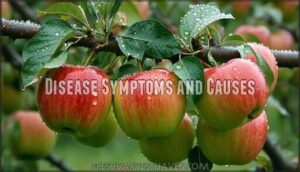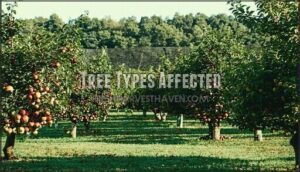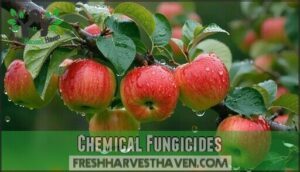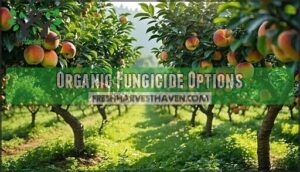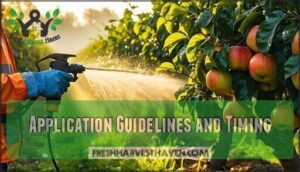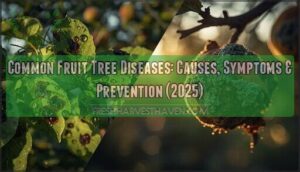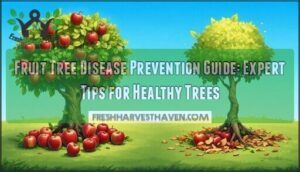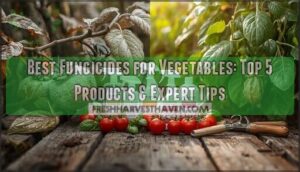This site is supported by our readers. We may earn a commission, at no cost to you, if you purchase through links.

Southern Ag Liquid Copper works wonders for fungal infections like rust and blight, while Ortho Max Garden Disease Control handles both fungi and pests.
For an organic touch, consider Neem-based sprays or Organic Fruit Tree Disease Control, which are eco-friendly and effective.
Timing is vital—apply early in the growing season to nip problems in the bud, and remember to always follow label directions and wear protective gear.
Healthy trees mean happier harvests, so let’s safeguard that backyard orchard smartly!
Table Of Contents
- Key Takeaways
- Fruit Tree Disease Overview
- Fungicide Types and Applications
- 5 Best Fungicides for Fruit Trees
- Effective Fungicide Use and Safety
- Frequently Asked Questions (FAQs)
- How to treat fungal infection on fruit trees?
- What is the most effective fungicide?
- When should I apply fungicide to fruit trees?
- How do you get rid of fungus on fruit?
- What is the best fungal treatment for fruit trees?
- How to treat a diseased fruit tree?
- Can fungicides harm beneficial insects or pollinators?
- How do weather conditions affect fungicide effectiveness?
- Are there alternative treatments for fungicide-resistant diseases?
- Can you mix fungicides with other pesticides safely?
- Conclusion
Key Takeaways
- Apply fungicides early in the season to prevent fungal diseases before they spread, following label directions carefully.
- Choose the right fungicide based on your needs, like Southern Ag Liquid Copper for rust or Neem-based sprays for an organic option.
- Always rotate fungicides from different FRAC groups to prevent resistance and ensure better long-term disease control.
- Improve air circulation by pruning and removing debris, and avoid spraying during bloom to protect pollinators.
Fruit Tree Disease Overview
Fruit tree diseases can strike unexpectedly, threatening the health of your trees and reducing fruit production.
Understanding common diseases, their symptoms, and the tree types they affect will help you protect your orchard effectively.
Common Fruit Tree Diseases
Fruit trees often face pesky fungal diseases like Apple Scab, Brown Rot, Powdery Mildew, and Cedar Rust, along with Bitter Rot.
Pesky fungal foes like Apple Scab, Brown Rot, and Powdery Mildew threaten fruit trees—spot symptoms early to protect your harvest.
These common fruit diseases cause spots, rotting, or mold on leaves and fruits, impacting your harvest.
A good fruit tree fungicide is essential for managing these fungal fruit diseases, ensuring healthy growth, and protecting your fruits all season.
Fungal spores spread through air and water, but proper tree care can help prevent infections, which is crucial for healthy growth and protecting your fruits.
Disease Symptoms and Causes
How do you know if your fruit trees are sick?
Identifying scab or brown rot symptoms, like brown spots or moldy growth, is key.
Powdery mildew leaves a white powder on leaves, while cedar rust causes orange, spiky galls.
These fungal diseases thrive in wet conditions, spreading quickly, and spot symptoms early to break the disease cycle and protect your trees.
Tree Types Affected
Apple, peach, cherry, and other fruit trees are vulnerable to diseases like apple scab, brown rot, powdery mildew, cedar rust, and bitter rot.
Apple tree fungus often affects leaves and fruits, while peach and cherry tree fungi can destroy blossoms and fruit.
Proper fruit tree fungicide use is essential to protect these trees from serious issues before diseases spread, ensuring the health of the trees.
Fungicide Types and Applications
Choosing the right fungicide means understanding the types available and how they work to protect your trees.
Whether you opt for chemical or organic solutions, proper application is key to preventing and controlling diseases effectively.
Chemical Fungicides
Chemical fungicides are a reliable ally in managing fruit tree diseases. They offer specific modes of action, from systemic action for internal protection to broad-spectrum types like copper.
Stay mindful of resistance risks by rotating FRAC Groups. Early disease detection is essential for preventing spread.
Here’s why they’re effective:
- Target fungal spores to prevent spread.
- Protect against multiple diseases.
- Offer both curative and protectant capabilities.
Organic Fungicide Options
Organic fruit fungicides offer safe, eco-friendly disease control for your trees.
Neem oil disrupts fungi, preventing spread, while copper sulfate is OMRI listed, tackling various diseases.
Baking soda serves as a simple solution for fungal spores.
Many gardeners find organic options available for their specific needs.
For sustainable options, biofungicides like Serenade protect against infections and support disease resistance, making them reliable choices for maintaining healthy fruit trees.
Application Guidelines and Timing
Timing your fungicide application is key to disease management.
Follow these steps for success:
- Spray early, during leaf development, for best timing.
- Adjust spray intervals based on disease pressure and weather conditions.
- Make certain thorough spray coverage for effective protection.
- Always follow fungicide rates from the label.
Proper spray timing safeguards your trees, promoting healthy growth and reducing disease risks, which is crucial for disease management.
5 Best Fungicides for Fruit Trees
Choosing the right fungicide for your fruit trees is key to managing diseases and protecting your harvest. Here are five proven options that offer reliable results for healthy, thriving trees.
1. Southern Ag Liquid Copper Fungicide Quart
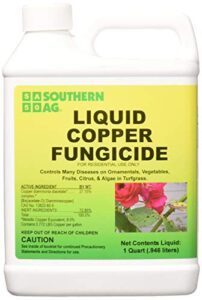
If there’s one fungicide that stands out for versatility and effectiveness, it’s Southern Ag Liquid Copper Fungicide Quart.
This liquid-form fungicide provides broad-spectrum control of fungal and bacterial issues, including leaf spots, rust, and blights.
It’s easy to mix, works with hose-end sprayers, and tackles moss and algae, too.
Suitable for fruits, vegetables, and ornamentals, it helps prevent infections with precise application.
Just verify you follow the label directions closely for safe use, and it’s a go-to solution for healthy trees!
Best For: Homeowners and gardeners looking for an effective solution to control bacterial and fungal diseases on plants, as well as moss and algae.
- Broad-spectrum disease control for various plants and surfaces
- Easy to mix and compatible with hose-end sprayers
- Effective for preventing infections when used as directed
- Requires manual application, adding extra effort
- Limited to residential use only
- Must carefully follow usage rates to avoid damaging plants
2. Ortho Max Garden Disease Insect Control
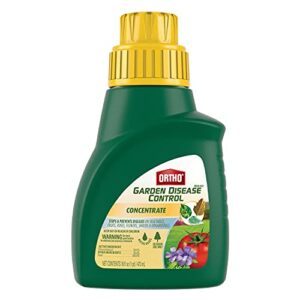
When tackling fruit tree diseases, Ortho Max Garden Disease Insect Control is a reliable choice. It stops and prevents common issues like rust, leaf spots, and fruit rots, offering wide coverage for vegetables, fruits, roses, and more.
Simple to use, just dilute as directed and spray when plants are around six inches tall or at the first sign of disease. Reapply every five days for consistent protection.
This product helps you maintain vibrant, healthy trees while controlling stubborn fungal problems.
Best For: Gardeners who need reliable disease control for fruits, vegetables, roses, and ornamental plants.
- Requires reapplication every five days for ongoing protection.
- Not organic and may not appeal to eco-conscious gardeners.
- Must be diluted, which could be inconvenient for some users.
- Controls a wide range of plant diseases like rust, leaf spots, and fruit rots.
- Easy to use with simple dilution and application instructions.
- Works on vegetables, fruits, and ornamental plants for versatility.
3. Organic Fruit Tree Disease Control
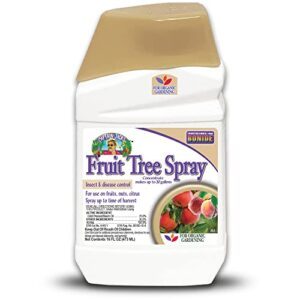
In the case of keeping your trees healthy, combining care techniques with natural sprays pays off.
Organic fruit tree disease control focuses on prevention and safe treatments, using products like neem oil, wettable sulfur, or potassium bicarbonate.
Pruning helps air circulation, while companion plants like marigolds deter pests.
Timing matters—apply sprays before infections strike.
Remember to inspect regularly and remove infected material during dormancy, always following product instructions for effectiveness, ensuring your fruit trees thrive without compromising safety or the environment, which is crucial for their healthy growth and environmental safety.
Best For: Home gardeners and orchardists seeking a cost-effective solution for managing pests and diseases on fruit trees and ornamental plants.
- Effective against a wide range of pests and fungal diseases.
- Long-lasting product, with minimal amounts needed per application.
- Enhances harvest quality when combined with other pest control methods.
- Requires careful handling and adherence to safety guidelines.
- May not completely resolve issues like worm infestations in peaches.
- Limited to a maximum of three applications after petal drop for some fruit types.
4. Eagle Fungicide for Plant Protection
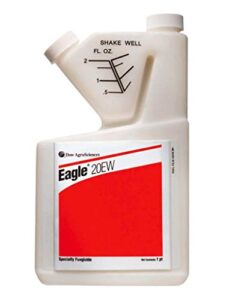
Eagle Fungicide delivers reliable protection for fruit trees against diseases like apple scab and powdery mildew.
Its systemic action allows it to penetrate deeply, safeguarding both existing and new foliage up to 28 days.
Mixing is straightforward—just follow the label instructions.
This fungicide’s versatility makes it ideal for apples, stone fruits, and even turfgrass.
With 1 pint making over 20 gallons of spray, it’s budget-friendly.
Always wear protective gear during application and verify that treated areas dry before allowing access.
Best For: Serious agricultural users managing fungal diseases on turf, ornamental plants, apples, stone fruits, and grapes.
- Effective against over 15 fungal diseases, including apple scab and powdery mildew.
- Systemic action offers up to 28 days of protection for new and existing growth.
- Budget-friendly with one pint mixing over 20 gallons of spray.
- Not suitable for small-scale applications (1-2 gallons).
- Requires proper protective equipment and careful handling during use.
- Limited usage restrictions in certain counties, like Nassau and Suffolk, NY.
5. Subdue Maxx Fungicide Control Solution
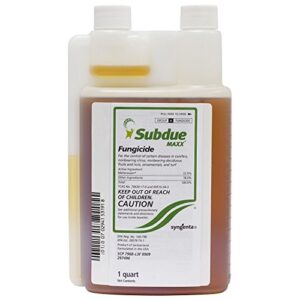
Subdue Maxx Fungicide, with its active ingredient mefenoxam, offers reliable protection against fruit tree diseases like root rot and damping-off.
This systemic fungicide penetrates plants, providing full coverage and control for fungi such as Pythium and Phytophthora.
Ideal for ornamentals and non-bearing trees, it’s effective in wet climates where fungal issues thrive.
Understanding the disease triangle elements is vital for effective prevention.
Although it’s pricier, its low application rate makes it long-lasting.
For best results, pair it with other fungicides to prevent resistance and guarantee your trees stay healthy all season.
Best For: Gardeners and landscapers dealing with fungal diseases like root rot or pythium in ornamentals, turf, and non-bearing trees.
- Systemic fungicide offering broad-spectrum control.
- Effective in wet climates against root and foliar diseases.
- Long-lasting due to low application rates.
- Expensive compared to other fungicides.
- Requires rotation with other products to prevent resistance.
- Limited availability, often purchased online.
Effective Fungicide Use and Safety
Using fungicides effectively means applying them at the right time and in the correct amounts to protect your fruit trees without causing harm.
Always follow label instructions, wear protective gear, and consider the environmental impact to guarantee safe and responsible use.
Spray Timing and Intervals
Spray timing for fruit tree fungicide is vital for disease management.
Apply at these ideal intervals:
- Growth Stage: At bud break and young leaf development.
- Disease Pressure: Every 7-14 days in high-pressure seasons.
- Weather Impact: Before rainfall with 2-3 hours drying time.
- Fungicide Type: Follow product-specific schedules for residual effectiveness.
Timely fungicide application guarantees healthier trees.
Safety Precautions and Protective Gear
Protect yourself when spraying fungicides by following key safety precautions. Always wear proper personal protective equipment like respirator masks, gloves, and eye protection.
For specialized needs, consider fungicide respirator options. Check out the table below for detailed guidelines:
| Equipment | Purpose | Tips |
|---|---|---|
| Respirator Masks | Prevent inhaling chemicals | Choose a certified, snug-fitting one |
| Glove Types | Shield hands from exposure | Use chemical-resistant gloves |
| Clothing Requirements | Protect skin from contact | Wear long sleeves and waterproof gear |
Always prioritize user and environmental safety by adhering to these steps during application, and remember to follow the key safety precautions to ensure your protection.
Environmental Impact and Withdrawal Periods
Fungicides impact the environment by affecting soil health, water contamination, and ecosystem effects.
Copper-based options can harm soil microbes and persist over time. Organic fungicides are safer but need frequent use.
Residue persistence influences withdrawal periods, ensuring safe harvests. Protect bee safety and minimize risks with proper timing and usage.
One key preventative measure is proper tree spacing for better air circulation. Always follow guidance to manage fruit tree diseases responsibly.
Frequently Asked Questions (FAQs)
How to treat fungal infection on fruit trees?
Begin treatment when trees leaf out.
Apply fungicides preventatively before rainfall, allowing them to dry.
Focus on systemic fungicides for deeper protection and rotate FRAC groups to prevent resistance while ensuring effective disease control.
What is the most effective fungicide?
Choosing a fungicide is like choosing the right tool for a repair job—copper works wonders for broad-spectrum use.
But systemic options like Aprovia and Indar excel by penetrating plants and tackling specific fungal threats effectively.
When should I apply fungicide to fruit trees?
You should spray fungicide when trees first leaf out, focusing on younger leaves, as prevention is key.
Apply before expected rainfall, allowing 2-3 hours to dry, and reapply every 2-3 weeks as needed.
How do you get rid of fungus on fruit?
Tackle fruit tree fungus by pruning infected areas, removing debris, and improving air circulation.
Apply copper or systemic fungicides preemptively or at early signs.
Act fast; timing matters to protect leaves and guarantee healthy growth.
What is the best fungal treatment for fruit trees?
To treat fungal diseases on fruit trees, use a systemic fungicide like Indar or Ridomil Gold SL for thorough protection.
Along with dormant sprays of copper, always rotate FRAC Groups to prevent resistance development.
How to treat a diseased fruit tree?
Imagine your tree’s lifeline slipping away—act fast!
Prune infected parts, clear debris, and spray a protectant fungicide like chlorothalonil early.
Rotate systemic options for stubborn diseases.
Healthy trees start with timely care!
Can fungicides harm beneficial insects or pollinators?
Fungicides can harm beneficial insects or pollinators if misapplied.
Always follow label instructions, avoid spraying during bloom, and target early morning or late evening when pollinator activity is low to minimize unintended impacts.
To ensure safe application, it is crucial to minimize unintended impacts by following these guidelines.
How do weather conditions affect fungicide effectiveness?
Weather greatly impacts fungicide effectiveness.
Rain washes sprays away, so apply before rain, allowing drying time.
High humidity boosts fungal growth, increasing need for treatment.
Extreme heat or cold affects plant absorption and chemical stability.
Are there alternative treatments for fungicide-resistant diseases?
When fungicides fail due to resistance, you can outsmart fungi with cultural practices: prune infected branches, remove debris, rotate crops, and choose resistant varieties.
Biofungicides, like Bacillus subtilis, also offer eco-friendly, effective alternatives.
Can you mix fungicides with other pesticides safely?
You can mix fungicides with other pesticides, but always check compatibility labels first.
Improper mixing can reduce effectiveness or harm plants.
Test small amounts before large-scale spraying, and make certain proper agitation for uniform blending, ensuring compatibility is maintained.
Conclusion
Protecting your fruit trees is like investing in a flourishing future—healthy trees bring delicious rewards season after season.
Choosing the best fungicide for fruit tree diseases depends on your needs, whether it’s Southern Ag Liquid Copper for rust or Neem-based sprays for organic care.
Apply fungicides early, follow the label carefully, and don’t skip protective gear, ensuring a proactive approach to keep your backyard orchard thriving and your harvests abundant year after year.
- https://www.cumminsnursery.com/learn-trees/growing-trees/fruit-tree-diseases-and-pests/diagnostics/
- https://www.newlifeonahomestead.com/fruit-tree-diseases/
- https://content.ces.ncsu.edu/disease-and-insect-management-in-the-home-orchard
- https://www.rhs.org.uk/science/articles/2022-diseases
- https://www.epicgardening.com/apple-tree-diseases/

